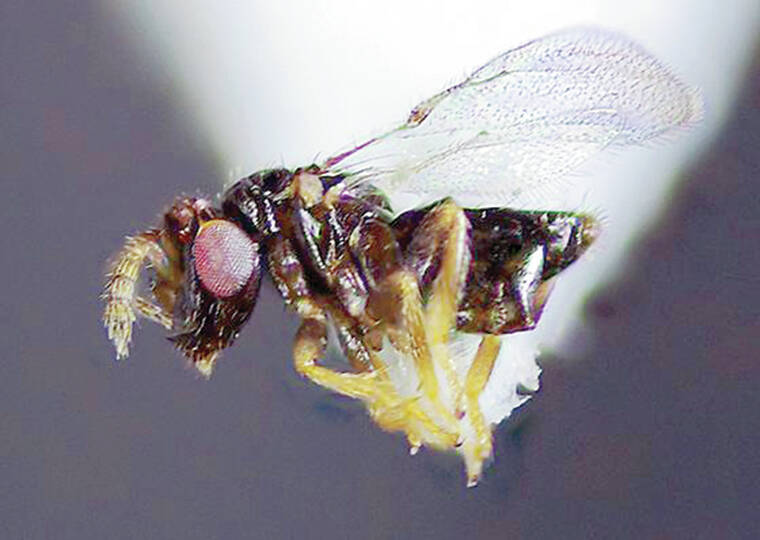Can wasps save Hawai‘i’s coffee industry?
LIHU‘E — It’s not very often people are happy to have wasps around.
Researchers from the University of Hawai‘i at Manoa and U.S. Department of Agriculture’s Agricultural Research Service are planning to release thousands of minuscule wasps on Hawai‘i Island coffee farms, in an effort to combat a plant-killing invasive beetle that threatens the state’s second largest crop.
First discovered in South Kona in August 2010, the coffee berry borer is a beetle native to Africa that has since spread to O‘ahu, Maui, Lana‘i and Kaua‘i. Females bore a hole into coffee berries — where coffee beans form — where they deposit eggs. Once hatched, the larvae feed on the coffee beans, reducing both yield and quality of coffee.
“It basically devastated the coffee crop,” said Peter Follett, a researcher at the U.S. Pacific Basin Agricultural Research Center. “Without control, it could infest basically 90-plus percent of the coffee berries, so a lot of coffee farmers basically gave up and went out of business.”
Within a few years, a combination of biopesticides and berry picking techniques were introduced to Hawai‘i’s coffee farms, keeping average infestation rates below 5 percent.
However, the recent rise of another equally damaging plant disease — coffee leaf rust — has further decimated the state’s coffee crops, making every successfully harvested coffee bean count, and putting pressure on farmers to more aggressively target coffee berry borers.
“The two pests are the most serious pests almost everywhere that coffee is grown around the world,” Follett said. “Now, we have them both.”
To aid in the battle against the beetles, researchers are calling on one of their natural enemies — a tiny wasp known as Phymastichus coffea.
Also native to Africa, the wasps are minuscule, typically no larger than 1 millimeter.
“If it landed on your nose, you wouldn’t know it was there,” Follett said. “You could raise a million wasps in something the size of a cup of coffee.”
Conveniently, the wasps are also parasitoids, meaning they seek out coffee berry borers and implant their eggs inside the beetles, where the wasp larvae eventually kill their host.
This relationship has been used as a biological control agent for years across coffee farms in Central America and South America, and researchers believe the same concept would be successful in Hawai‘i.
“This biological control agent has the potential to make significant positive economic impacts in the Hawai‘i coffee industry, and offers an environmentally safe way to manage (coffee berry borers),” said Mark Wright, entemology professor and extension specialist at UH Manoa. “The Hawai‘i coffee industry is economically and culturally significant, and we hope that this work will improve the lives of many people associated with the industry.”
To determine the wasp’s potential ecological impacts, researchers on Hawai‘i Island have spent more than four years ensuring no unintentional consequences would occur if the wasps were released into the ecosystem. Under strict quarantine, they exposed the wasps to a series of native and nonnative beetles, ultimately finding that the wasps would only attack species very closely related to the coffee berry borer — all of which are invasive to Hawai‘i.
“That’s why we think that we can bring it in and we can release it, and it’s unlikely to have any impacts — because it doesn’t attack any native species and has a very limited host range,” Follett said.
Additionally, the wasps are harmless to humans, neither providing a significant sting nor pathogenic risk.
“It doesn’t sting people,” Follett said. “If you grabbed a bunch of them and put them in a bad position, they might try and poke you with their ovipositor, but you wouldn’t feel a thing. So it is a wasp, and that’s a loaded word because it sounds dangerous, but it’s not dangerous.”
While the researchers have received the necessary permitting from the state, they still must receive additional permits from the U.S. Department of Agriculture before the project can proceed — although Follett is optimistic they’ll come soon, and suggested limited first releases could occur as soon as late fall.
And while the project is only currently set for deployment on Hawai‘i Island, Follett told The Garden Island a successful release there would likely encourage expansion projects on other Hawaiian Islands — including to coffee farms on Kaua‘i.
“We’re happy to deploy the wasps everywhere that the coffee berry borer is,” he said. “We’re very willing to, once we start raising these, distribute the wasps to everyone for release, and we’re happy to come to Kaua‘i.”
•••
Jackson Healy, reporter, can be reached at 808-647-4966 or jhealy@thegardenisland.com.


Are they still growing coffee on Kaua’i? When the pandemic hit in 2020, this should have wiped out all of it. The whole industry for coffee should have been decimated. Where’s the coffee still at on Kaua’i?
Yeah what can possible go wrong? I mean look at all the lovely mongoose on the other islands. And the delicious ta’ape released by DNLR in the 1950s. Those scientists thought they were right too. And those rabbits in Australia – how did that work out?